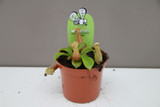
Nepenthes alata
Nepenthes alata
Nepenthes alata is going to help us learn a new word, today; polymorphic. Can you use it in a sentence? Nepenthes alata is highly polymorphic..? In lamen terms, it just means that this tropical pitcher plant from the Phillipines is highly variable and has plants within the species that display a variety of traits – like pitcher shape, coloration, etc. To solidify this concept, imagine a black jaguar vs. a spotted jaguar. They’re both jaguars, but they’re displaying different phenotypical, or outwardly-physical traits.
In the case of Nepenthes alata, all of these different forms, or “morphs” of the plant are considered the same species even though they have different physical, or phenotypic expression of their genes, because they all inhabit the same location, and all randomly interbreed with one-another.
By the way, if you’re looking for a great beginner’s Nepenthes, this is one of the heartiest, most forgiving species you could start with. It’s frequently hybridized with N. ventricosa to create the uber robust N. ventrata (get it? ventricosa + alata).
Pitcher characteristics
“Ala” is Latin for “wing,” and refers to Nepenthes alata’s prominent lower pitcher wings. As mentioned, the plant is highly polymorphic, with pitcher’s ranging from yellow-green, to red, to speckled, orange, purple, and a variety of configurations in-between. Pitcher shape tends to be slender expanding into a bulbous lower third, closest to the tendril. Peristomes are simple and narrow and give way to a tear-drop shaped mouth.
Lower pitchers are around 7 in (18 cm) tall, and uppers tap out around 9 in (23 cm). Nepenthes alata supports abundant simultaneous pitcher development – it grows so quickly, you can have a dozen healthy pitchers on one plant at a time.
Other notable characteristics
Nepenthes alata naturally grows from sea level up to about 6,200 ft (1,900 m), but it’s sweet spot is below 4,600 ft (1,400 m). Technically, this makes it mostly a lowland plant, but it’s also tolerant of highland conditions, so it’s a bit of an intermediary grower. N. alata isn’t too picky about growing conditions, and will grow both terrestrially, and as an epiphyte (growing in trees).
This tropical pitcher plant is a scrambler, growing as an ever-taller mass of leaves and pitchers attached to a narrow stem. Because of this, it’s often found tangled in and supported by bushes and tree branches.







